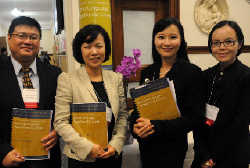Acquiring the World's Most Common Language
TC hosts the world's first conference on how non-native speakers learn Chinese
The reasons are obvious. China’s economy is now the second largest in the world; Mandarin Chinese is the world’s most commonly spoken language; and there are now 50 million people worldwide who speak Chinese as a second language. In the U.S., more than 1,200 elementary and secondary schools are incorporating Chinese language learning into their curricula, and across the world.
“Clearly there could not be a better moment to focus on the growing role that China and Chinese will play in our lives,” President Susan Fuhrman said in October at TC’s first Roundtable in Second Language Studies on the Second Language Acquisition of Chinese.
At the same time, during the past two decades there has been an explosion of new research in the field of second language acquisition (SLA), giving rise to a range of theoretical approaches that include the behavioral, the psycholinguistic and the generative (which posits the notion of a universal grammar underlying all languages). The research, in turn, has spawned new teaching methodologies such as task-based language learning (TBLT), which requires the student to use the second language to solve everyday problems and tasks, and Focus on Form, which seeks to bridge methodologies that treat accuracy and fluency separately.
TC’s ZhaoHong Han, Associate Professor of Language and Education and herself a leading SLA researcher, has devoted much of her career to applying those findings to classroom instruction of second languages. A few years ago, Han, whose recent published books include Second Language Reading, Research and Instruction: Crossing the Boundaries (co-edited with Neil J. Anderson) and Linguistic Relativity in SLA: Thinking for Speaking (co-edited with Teresa Cadierno), founded one of the world’s first programs in TCSOL (the teaching of Chinese to speakers of other languages), which she continues to co-direct. And over the past year and a half, working under her guidance, four of her doctoral students—Yayun Anny Sun, K. Philip Choong, Hye Won Shin and Shaoyan Qi—organized the conference that took place in October.
The event was the first to bring together TCSOL practitioners, second language acquisition researchers, education publishers and other stakeholders in Chinese language instruction to learn from one another. The nearly 200 attendees came from South Africa, Hong Kong, Singapore, Kenya, New Zealand, the United Kingdom, Saudi Arabia, China and elsewhere.
But what really made the conference unique was that it focused “on the learning of this unique language, as opposed to the teaching of it.
“The field of second language acquisition, to date, has been dominated by what we know about how people learn English—and while some of those lessons apply, many surely do not,” Fuhrman said. “And—as has become increasingly evident in all fields of knowledge—it really is not possible to teach effectively without understanding what is going on in the mind of the learner.”
To that end, more than 90 papers and posters were presented, addressing topics ranging from reading and vocabulary acquisition and phonological acquisition to the role of linguistic relativity (differences in how learners’ native languages affect cultural and cognitive lenses) in the acquisition of Chinese motion verbs.
“We wanted to host a conference that was research-based, as opposed to strictly pedagogy-based,” says Choong. “We’re both teachers and researchers—there’s a need to connect these two worlds.”
The conference featured two plenary speakers, Nick Ellis, Professor of Psychology and English Language Institute Research Scientist at the University of Michigan, and Boping Yuan, University Senior Lecturer at University of Cambridge. Ellis, who has done computational modeling of how second languages are acquired, presented a comprehensive overview of the most important findings in SLA over the past 20 years. Yuan’s discussed ways that SLA research methodology from the generative tradition could be applied to analyzing Chinese language structures that are especially problematic for second-language learners. (The generative tradition posits a universal grammar that underlies all languages.) Ellis spoke in English, Yuan in Chinese, and neither address was translated—a decision by the organizers to ensure “equal representation” of languages.
A pre-conference workshop on TBLT included classroom-specific suggestions for Chinese language learning, including both pedagogic and real-world tasks to organize teaching, learning, and assessment activities.
Sun, one of the student co-chairs, says the conference was successful in “calling attention to the learning processes of Chinese. We opened the door wider.”
Published Monday, Nov. 22, 2010
